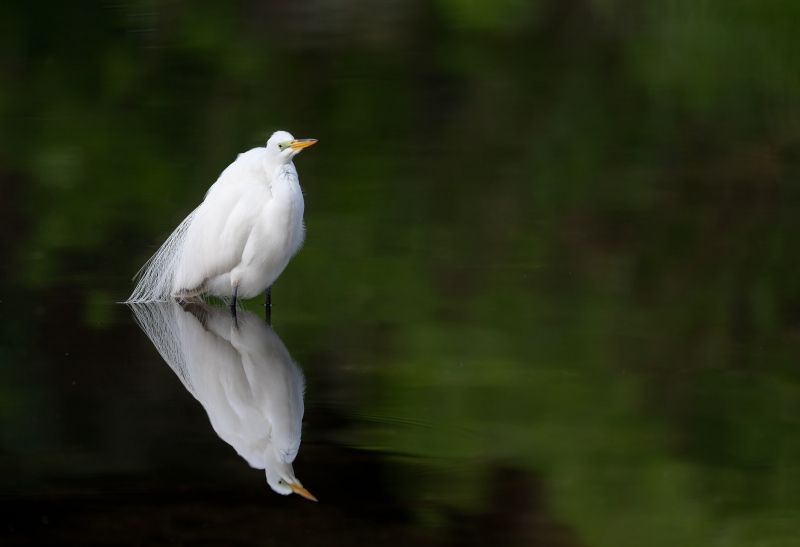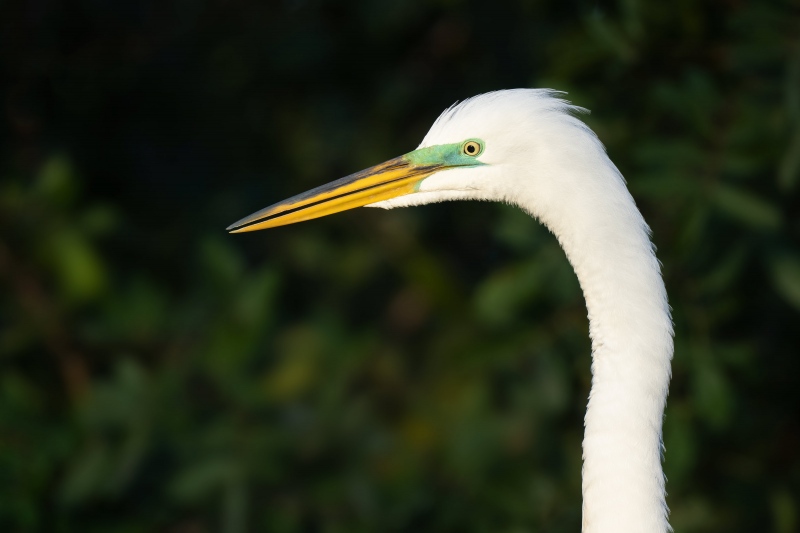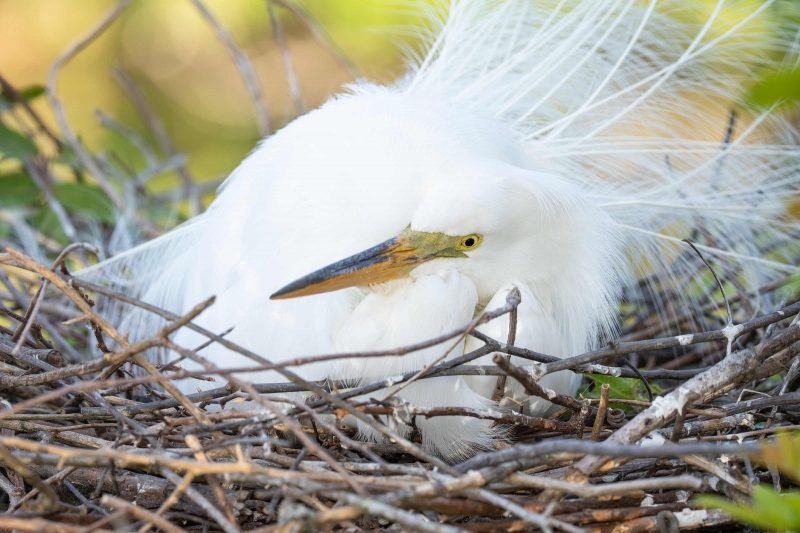What’s Up
While checking the crane on the nest before the sun was fully up — the bird was sleeping on the two eggs (as usual), I spotted two adult Brown Pelicans flying over the lake not far from the shore. They were the first in more than 20 years of observation. Then, using the hand held 200-600 (and wishing I had taken the 600 f/4 and the 1.4X TC), I carefully approached some Great Egret gorging on baitfish in the canal at the north end of ILE. I got a few good ones. After brunch, an early nap, my bursts, and my swim I drove over to my AirBnB in Valrico. At 5pm, I met up with Jon Hoiles at the rookery in Brandon. We had a great time with lots of flight action. Images and story at some point.
Today is Tuesday 29 March 2022. The forecast for Gibsonton is for mostly sunny with a very gentle breeze from the N/NW switching to northeast early. My group of four will be meeting Captain James Shadle aboard the Hooptie Deux at 6:30am sharp. Speaking of spoonbills, the Wednesday morning trip still has three openings and the forecast is for a southeast wind. Yummy for flight photography. Details below. Wherever you are and whatever you are doing, I hope that you too have a great day. This blog post about 90 minutes to prepare and makes nineteen days in a row with a new one.
Please remember to use the B&H and Amazon links that are found on most blog pages and to use the BIRDSASART discount code at checkout when purchasing your new gear from Bedfords. Please, also, consider joining a BAA IPT. You will be amazed at how much you will learn …
Gatorland In-the-Field Instruction: Saturday April 2 2022, 2 1/2 hours from 7:00 – 9:30am for a ridiculously low $200.00. Limit two photographers.
Please contact me via e-mail to reserve a spot. Payment by cash or check before boarding the boat will be fine.
Unsolicited e-Mail from Jon Hoiles
Thanks again for a wonderful morning at Gatorland. As I said on Sunday morning, it was an awesome experience for me, not only meeting you, but having the 1:1 time in the field. I was half-expecting to get a few tips and then we’d go shoot, and that would have been good with me. But to get a solid 2.5 hours of hands-on, no-holds-barred photography training time from the best just blew me away. Thank you! I sincerely appreciate how you helped with both the technical aspects of operating the camera (and even the tripod head!) and the creative process of composing an image and using the light to your advantage. And the role of the wind in bird photography! I don’t think I would have gotten the backlit egret with rim-light image if I had been using manual with auto-ISO.
Very Short Notice Hooptie Deux Roseate Spoonbill Opportunities
Morning Roseate Spoonbill Session: 7-10am on the boat
Wednesday 30 March 2022: $500 includes the boat fees, waders, and in-the field instruction.
Limit 5 photographers/openings: 3.
Add a working brunch with image review: $125.00.
As above, there are 3 spots left on the Wednesday morning Hooptie Deux spoonbill trip. Please contact me via e-mail to reserve a spot. Payment by cash or check before boarding the boat will be fine.
|
|
|
This image was created on 27 March 2022. I used the no-longer-available Induro GIT 304L/Levered-Clamp FlexShooter Pro-mounted Sony FE 600mm f/4 GM OSS lens and The One, the Sony Alpha 1 Mirrorless Digital Camera. ISO 1000. The exposure was determined via Zebras with ISO on the rear wheel: 1/60 sec. at f/4 (wide open) in Manual mode. AWB at 7:17:29am on what would be a sunny morning. Tracking: Spot S with Bird Face/Eye detection enabled performed perfectly. Be sure to click on the image to enjoy the high-res version. Image #1: Great Egret pre-dawn in dark relefctions |
Slow Shutter Speeds and Big Glass
Many folks (including new student and friend Jon Hoiles), believe that they need to use shutter speeds in excess of 1/500 second when using a tripod-mounted 500 or 600mm lens. I believe that with good sharpness techniques and some practice, most folks will be able to create razor sharp images at least down to 1/60 sec. Doing do will save you at least three stops of ISO.
|
|
|
This image was created 27 March 2022 at Gatorland in Kissimmee, FL. I used the no-longer available Induro GIT304L Stealth Carbon Fiber Tripod/Levered-Clamp FlexShooter Pro-mounted-Sony FE 600mm f/4 GM OSS lens, the Sony FE 2.0x Teleconverter, and The One, the Sony Alpha 1 Mirrorless Digital Camera). ISO 1250. 1/640 sec. at f/8 (wide open) in Manual Mode. The exposure, determined using Zebra technology, was dead-solid perfect when evaluated in RawDigger. AWB at 7:51:27am on a clear sunny morning. Tracking: Spot S Bird Face/Eye detection performed to perfection. Be sure to click on the image to enjoy a high-res version. Image #1: Great Egret in breeding plumage/head and neck portrait |
Manual Mode Rocks
Learning to work in Manual mode is a necessity if you want to learn to make consistent exposures and become a better bird photographer. And the last thing that you want to do, is to use Auto ISO in conjunction with Manual (exposure) mode. The beauty of working in manual mode is that you have complete control over all three exposure parameters. Once you go to Auto ISO, you are giving up control. If working in Manual mode scares you, check out the great tutorial in the blog post here.
|
|
|
This image was created on 27 March 2022 at Gatorland. I used the hand held Sony FE 200-600mm f/5.6-6.3 G OSS lens (at 318mm), and The One, the Sony Alpha 1 Mirrorless digital camera. ) The exposure was determined using Zebra technology with ISO on the Thumb Dial. ISO 800. 1/250 second at f/8 (stopped down 2/3 stop).AWB at 9:16:44 in the shade on a sunny morning. Tracking: Spot S with Bird/Face-Eye Detection performed perfectly. Be sure to click on the image to enjoy a high-res version. Image #3: Great Egret on nest with aigrettes fluffed up
|
Embracing the Clutter
On rare occasions, you can actually work with the jumble of sticks that comprise a wading bird nest and create a successful image by integrating and working around and with the clutter. If that makes any sense. Here I zoomed out to include the spray of the bird’s aigrettes to soften the look of the image. A single small twig that intersected with the tip of the bill was removed (seamlessly).
Typos
With all blog posts, feel free to e-mail or to leave a comment regarding any typos or errors.

















WoW! Great portraits 1&2. #2 nice and warm. I often think that the whites are overexposed until I click for the larger version, and nope, you are dead on. #3 I’m talking about.
With good technique and “the one”, folks are sure to get a keeper or two with slow shutter. It’s hard…lots of sleep, practice, hold your breath works works for me.
Thanks, Anthony. Remember that WHITEs in soft light rarely show any fine feather detail.
with love, artie